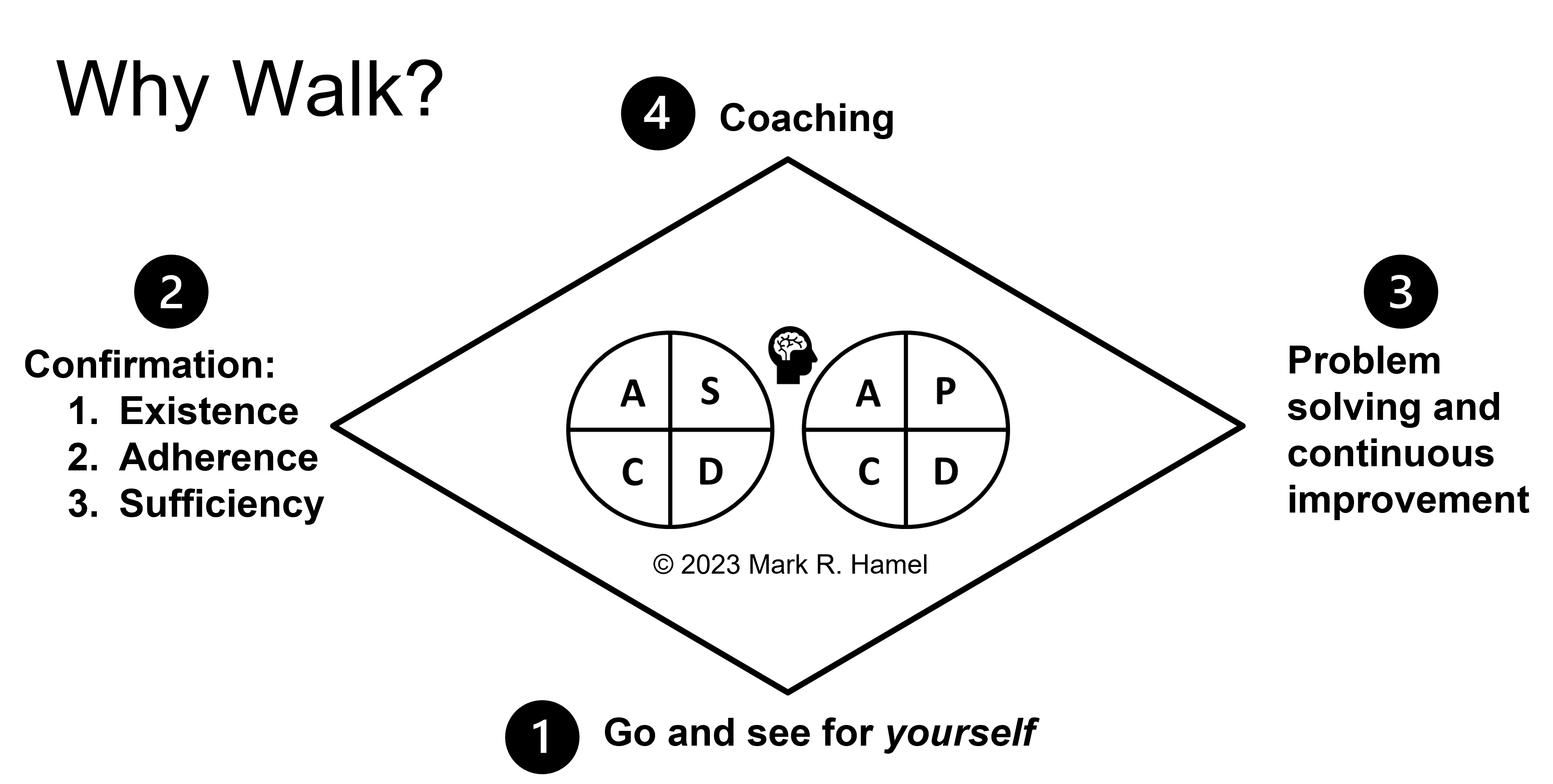
Mention the term “gemba walk” among a group of lean practitioners and there will likely be immediate acknowledgement. We’ve all heard of gemba walks, right?
All leaders should do them.
Many do not.
Many do…but certainly not in the same way and not necessarily for the same reason.
It’s like “working out.” One person’s idea of working out in terms of purpose, process, frequency, venue, and so on is often different than another person’s idea. For example, person A is engaged in post-surgery rehab and is, for the time being, limited to walking and minimal stretching. In contrast, person B is training for a triathlon, seeking to achieve a personal best, and incorporating a boatload of weight training, running, swimming, and cycling. Both are “working out,” but they have unique needs and concepts.
Similarly, different folks envision different things when they hear the term “gemba walk.”
As Thomas Aquinas noted, “What is received is received in the mode of the receiver.” The mode, which we may construe as mindset and frame of reference, is developed, and reinforced by past and current practice, training, leader focus, culture, and coaching. For example, if an organization treats gemba walks merely as an exercise in industrial tourism done to superficially satisfy a corporate mandate and the leaders “grew up” in that environment, then folks are probably going to think the gemba walk purpose is trivial.
The figure at the top of the post reflects what I see as the four fundamental, but not mutually exclusive, purposes of a gemba walk. They are summarized as follows:
- Go and see for yourself. We should recall Taiichi Ohno’s unambiguous preference for facts over data. Facts are gleaned from direct observation. They are firsthand. Data, while important, is a forensic, secondhand capturing or accounting of the stuff that already happened at the gemba. Then, there are opinions, theories, and fanciful, often biased, thoughts for which their veracity is commensurate with the seniority of the person who states them. Wait, what?!? Translation - sometimes senior leaders think what they say is fact when it could/should be disproved by a visit to the gemba. This is why we should talk less and walk more.
- Confirmation of existence, adherence, and sufficiency. Consistent with the scientific model of standardize-do-check-act (SDCA), as regularly embodied in gemba walk leader standard work, ALL leaders within their scope of responsibility must regularly go to gemba and directly observe. Assisted by robust visual process adherence controls (i.e., operator standard work, FIFO lanes, andons), leaders should be able, at-a-glance, to discern whether: 1) a standard exists, 2) if folks are adhering to the standard, and 3) the standard is sufficient to achieve the desired outcome (i.e., a quality product safely produced within the planned cycle time).
- Problem solving and continuous improvement. SDCA is virtually always accompanied by the better-known, but not more important, PDCA. The former provides a view into the health of the process or system and the platform for the next improvement (remember Ohno’s warning that without standards, there is no kaizen…not to mention no sustainability). There’s a reason why there is often a “grasp the situation” (GTS) circle within the center of the four-quadrant PDCA wheel. GTS touches and informs all aspects of P, D, C, and A. For example, one can’t “check” on the sufficiency of the thus-far-implemented plan without the rigor of direct observation. Similarly, one can’t learn from the experiment, and if one can’t learn, then one can’t even begin to “act.” This leads to the fourth purpose of gemba walks.
- Coaching. Gemba walks serve as a consummate coaching venue. The walks are typically incorporated within a management system’s gemba walk leader standard work (LSW) and/or coaching kata. The leader/coach’s gemba walk provides an opportunity to directly observe their coachee operating within the management system (and follow-up on coachee homework status). This includes not only the coachee’s gemba walk LSW performance, but also their huddle and andon response LSW performance. The leader/coach is ready to coach after integrating the new observation with prior ones. This helps them to better discern behavioral patterns and process improvement progress and build upon prior coaching cycles.
That’s my quick cut. What do you think is the purpose of a gemba walk?
By the way, I intend to entitle my next post “Gemba Walks: Who You Walk with Matters.”
